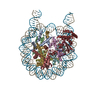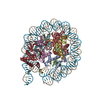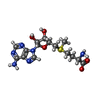+ Open data
Open data
- Basic information
Basic information
| Entry | Database: PDB / ID: 8jhg | ||||||
|---|---|---|---|---|---|---|---|
| Title | Native SUV420H1 bound to 167-bp nucleosome | ||||||
 Components Components |
| ||||||
 Keywords Keywords | GENE REGULATION/DNA /  nucleosome complex / nucleosome complex /  histone methyltransferase / GENE REGULATION-DNA complex histone methyltransferase / GENE REGULATION-DNA complex | ||||||
| Function / homology |  Function and homology information Function and homology informationhistone H4K20me methyltransferase activity / [histone H4]-N-methyl-L-lysine20 N-methyltransferase / histone H4K20 monomethyltransferase activity / [histone H4]-lysine20 N-methyltransferase / histone H4K20 methyltransferase activity / histone H4 methyltransferase activity / positive regulation of isotype switching / condensed chromosome, centromeric region /  S-adenosyl-L-methionine binding / muscle organ development ...histone H4K20me methyltransferase activity / [histone H4]-N-methyl-L-lysine20 N-methyltransferase / histone H4K20 monomethyltransferase activity / [histone H4]-lysine20 N-methyltransferase / histone H4K20 methyltransferase activity / histone H4 methyltransferase activity / positive regulation of isotype switching / condensed chromosome, centromeric region / S-adenosyl-L-methionine binding / muscle organ development ...histone H4K20me methyltransferase activity / [histone H4]-N-methyl-L-lysine20 N-methyltransferase / histone H4K20 monomethyltransferase activity / [histone H4]-lysine20 N-methyltransferase / histone H4K20 methyltransferase activity / histone H4 methyltransferase activity / positive regulation of isotype switching / condensed chromosome, centromeric region /  S-adenosyl-L-methionine binding / muscle organ development / S-adenosyl-L-methionine binding / muscle organ development /  histone methyltransferase activity / positive regulation of double-strand break repair via nonhomologous end joining / negative regulation of megakaryocyte differentiation / protein localization to CENP-A containing chromatin / Chromatin modifying enzymes / Replacement of protamines by nucleosomes in the male pronucleus / CENP-A containing nucleosome / epigenetic regulation of gene expression / Packaging Of Telomere Ends / Recognition and association of DNA glycosylase with site containing an affected purine / Cleavage of the damaged purine / Deposition of new CENPA-containing nucleosomes at the centromere / Recognition and association of DNA glycosylase with site containing an affected pyrimidine / Cleavage of the damaged pyrimidine / Inhibition of DNA recombination at telomere / Meiotic synapsis / telomere organization / RNA Polymerase I Promoter Opening / Interleukin-7 signaling / SUMOylation of chromatin organization proteins / Assembly of the ORC complex at the origin of replication / histone methyltransferase activity / positive regulation of double-strand break repair via nonhomologous end joining / negative regulation of megakaryocyte differentiation / protein localization to CENP-A containing chromatin / Chromatin modifying enzymes / Replacement of protamines by nucleosomes in the male pronucleus / CENP-A containing nucleosome / epigenetic regulation of gene expression / Packaging Of Telomere Ends / Recognition and association of DNA glycosylase with site containing an affected purine / Cleavage of the damaged purine / Deposition of new CENPA-containing nucleosomes at the centromere / Recognition and association of DNA glycosylase with site containing an affected pyrimidine / Cleavage of the damaged pyrimidine / Inhibition of DNA recombination at telomere / Meiotic synapsis / telomere organization / RNA Polymerase I Promoter Opening / Interleukin-7 signaling / SUMOylation of chromatin organization proteins / Assembly of the ORC complex at the origin of replication /  DNA methylation / Condensation of Prophase Chromosomes / HCMV Late Events / Chromatin modifications during the maternal to zygotic transition (MZT) / ERCC6 (CSB) and EHMT2 (G9a) positively regulate rRNA expression / SIRT1 negatively regulates rRNA expression / DNA methylation / Condensation of Prophase Chromosomes / HCMV Late Events / Chromatin modifications during the maternal to zygotic transition (MZT) / ERCC6 (CSB) and EHMT2 (G9a) positively regulate rRNA expression / SIRT1 negatively regulates rRNA expression /  innate immune response in mucosa / PRC2 methylates histones and DNA / Defective pyroptosis / HDACs deacetylate histones / RNA Polymerase I Promoter Escape / Nonhomologous End-Joining (NHEJ) / Transcriptional regulation by small RNAs / Formation of the beta-catenin:TCF transactivating complex / RUNX1 regulates genes involved in megakaryocyte differentiation and platelet function / Activated PKN1 stimulates transcription of AR (androgen receptor) regulated genes KLK2 and KLK3 / NoRC negatively regulates rRNA expression / G2/M DNA damage checkpoint / B-WICH complex positively regulates rRNA expression / HDMs demethylate histones / DNA Damage/Telomere Stress Induced Senescence / Metalloprotease DUBs / PKMTs methylate histone lysines / RMTs methylate histone arginines / innate immune response in mucosa / PRC2 methylates histones and DNA / Defective pyroptosis / HDACs deacetylate histones / RNA Polymerase I Promoter Escape / Nonhomologous End-Joining (NHEJ) / Transcriptional regulation by small RNAs / Formation of the beta-catenin:TCF transactivating complex / RUNX1 regulates genes involved in megakaryocyte differentiation and platelet function / Activated PKN1 stimulates transcription of AR (androgen receptor) regulated genes KLK2 and KLK3 / NoRC negatively regulates rRNA expression / G2/M DNA damage checkpoint / B-WICH complex positively regulates rRNA expression / HDMs demethylate histones / DNA Damage/Telomere Stress Induced Senescence / Metalloprotease DUBs / PKMTs methylate histone lysines / RMTs methylate histone arginines /  Meiotic recombination / Pre-NOTCH Transcription and Translation / Meiotic recombination / Pre-NOTCH Transcription and Translation /  nucleosome assembly / Activation of anterior HOX genes in hindbrain development during early embryogenesis / HCMV Early Events / Transcriptional regulation of granulopoiesis / structural constituent of chromatin / UCH proteinases / nucleosome assembly / Activation of anterior HOX genes in hindbrain development during early embryogenesis / HCMV Early Events / Transcriptional regulation of granulopoiesis / structural constituent of chromatin / UCH proteinases /  nucleosome / antimicrobial humoral immune response mediated by antimicrobial peptide / E3 ubiquitin ligases ubiquitinate target proteins / Recruitment and ATM-mediated phosphorylation of repair and signaling proteins at DNA double strand breaks / nucleosome / antimicrobial humoral immune response mediated by antimicrobial peptide / E3 ubiquitin ligases ubiquitinate target proteins / Recruitment and ATM-mediated phosphorylation of repair and signaling proteins at DNA double strand breaks /  gene expression / RUNX1 regulates transcription of genes involved in differentiation of HSCs / chromatin organization / gene expression / RUNX1 regulates transcription of genes involved in differentiation of HSCs / chromatin organization /  methylation / Factors involved in megakaryocyte development and platelet production / Processing of DNA double-strand break ends / HATs acetylate histones / antibacterial humoral response / Senescence-Associated Secretory Phenotype (SASP) / Oxidative Stress Induced Senescence / killing of cells of another organism / Estrogen-dependent gene expression / defense response to Gram-negative bacterium / methylation / Factors involved in megakaryocyte development and platelet production / Processing of DNA double-strand break ends / HATs acetylate histones / antibacterial humoral response / Senescence-Associated Secretory Phenotype (SASP) / Oxidative Stress Induced Senescence / killing of cells of another organism / Estrogen-dependent gene expression / defense response to Gram-negative bacterium /  chromosome, telomeric region / Ub-specific processing proteases / defense response to Gram-positive bacterium / chromosome, telomeric region / Ub-specific processing proteases / defense response to Gram-positive bacterium /  cadherin binding / Amyloid fiber formation / protein heterodimerization activity / negative regulation of cell population proliferation / cadherin binding / Amyloid fiber formation / protein heterodimerization activity / negative regulation of cell population proliferation /  DNA repair / DNA repair /  chromatin binding / protein-containing complex / chromatin binding / protein-containing complex /  DNA binding / DNA binding /  extracellular space / extracellular space /  RNA binding / extracellular exosome / extracellular region / RNA binding / extracellular exosome / extracellular region /  nucleoplasm / nucleoplasm /  membrane / membrane /  metal ion binding / metal ion binding /  nucleus / nucleus /  cytosol cytosolSimilarity search - Function | ||||||
| Biological species |   Homo sapiens (human) Homo sapiens (human) | ||||||
| Method |  ELECTRON MICROSCOPY / ELECTRON MICROSCOPY /  single particle reconstruction / single particle reconstruction /  cryo EM / Resolution: 3.58 Å cryo EM / Resolution: 3.58 Å | ||||||
 Authors Authors | Lin, F. / Li, W. | ||||||
| Funding support |  China, 1items China, 1items
| ||||||
 Citation Citation |  Journal: Cell Discov / Year: 2023 Journal: Cell Discov / Year: 2023Title: Structural basis of nucleosomal H4K20 recognition and methylation by SUV420H1 methyltransferase. Authors: Folan Lin / Ruxin Zhang / Weihan Shao / Cong Lei / Mingxi Ma / Ying Zhang / Zengqi Wen / Wanqiu Li /  Abstract: Histone lysine methyltransferase SUV420H1, which is responsible for site-specific di-/tri-methylation of histone H4 lysine 20 (H4K20), has crucial roles in DNA-templated processes, including DNA ...Histone lysine methyltransferase SUV420H1, which is responsible for site-specific di-/tri-methylation of histone H4 lysine 20 (H4K20), has crucial roles in DNA-templated processes, including DNA replication, DNA damage repair, and chromatin compaction. Its mutations frequently occur in human cancers. Nucleosomes containing the histone variant H2A.Z enhance the catalytic activities of SUV420H1 on H4K20 di-methylation deposition, regulating early replication origins. However, the molecular mechanism by which SUV420H1 specifically recognizes and deposits H4K20 methyl marks on nucleosomes remains poorly understood. Here we report the cryo-electron microscopy structures of SUV420H1 associated with H2A-containing nucleosome core particles (NCPs), and H2A.Z-containing NCPs. We find that SUV420H1 makes extensive site-specific contacts with histone and DNA regions. SUV420H1 C-terminal domain recognizes the H2A-H2B acidic patch of NCPs through its two arginine anchors, thus enabling H4K20 insertion for catalysis specifically. We also identify important residues increasing the catalytic activities of SUV420H1 bound to H2A.Z NCPs. In vitro and in vivo functional analyses reveal that multiple disease-associated mutations at the interfaces are essential for its catalytic activity and chromatin state regulation. Together, our study provides molecular insights into the nucleosome-based recognition and methylation mechanisms of SUV420H1, and a structural basis for understanding SUV420H1-related human disease. | ||||||
| History |
|
- Structure visualization
Structure visualization
| Structure viewer | Molecule:  Molmil Molmil Jmol/JSmol Jmol/JSmol |
|---|
- Downloads & links
Downloads & links
- Download
Download
| PDBx/mmCIF format |  8jhg.cif.gz 8jhg.cif.gz | 365.6 KB | Display |  PDBx/mmCIF format PDBx/mmCIF format |
|---|---|---|---|---|
| PDB format |  pdb8jhg.ent.gz pdb8jhg.ent.gz | 275.9 KB | Display |  PDB format PDB format |
| PDBx/mmJSON format |  8jhg.json.gz 8jhg.json.gz | Tree view |  PDBx/mmJSON format PDBx/mmJSON format | |
| Others |  Other downloads Other downloads |
-Validation report
| Arichive directory |  https://data.pdbj.org/pub/pdb/validation_reports/jh/8jhg https://data.pdbj.org/pub/pdb/validation_reports/jh/8jhg ftp://data.pdbj.org/pub/pdb/validation_reports/jh/8jhg ftp://data.pdbj.org/pub/pdb/validation_reports/jh/8jhg | HTTPS FTP |
|---|
-Related structure data
| Related structure data |  36265MC  8jhfC M: map data used to model this data C: citing same article ( |
|---|---|
| Similar structure data | Similarity search - Function & homology  F&H Search F&H Search |
- Links
Links
- Assembly
Assembly
| Deposited unit | 
|
|---|---|
| 1 |
|
- Components
Components
-Protein , 5 types, 9 molecules KAEBFCGDH
| #1: Protein | Mass: 41330.703 Da / Num. of mol.: 1 Source method: isolated from a genetically manipulated source Source: (gene. exp.)   Homo sapiens (human) / Gene: KMT5B, SUV420H1, CGI-85 / Production host: Homo sapiens (human) / Gene: KMT5B, SUV420H1, CGI-85 / Production host:   Escherichia coli (E. coli) Escherichia coli (E. coli)References: UniProt: Q4FZB7, [histone H4]-N-methyl-L-lysine20 N-methyltransferase, [histone H4]-lysine20 N-methyltransferase | ||||||
|---|---|---|---|---|---|---|---|
| #2: Protein |  Histone H3 / Histone H3/a / Histone H3/b / Histone H3/c / Histone H3/d / Histone H3/f / Histone H3/h / Histone ...Histone H3/a / Histone H3/b / Histone H3/c / Histone H3/d / Histone H3/f / Histone H3/h / Histone H3/i / Histone H3/j / Histone H3/k / Histone H3/l Histone H3 / Histone H3/a / Histone H3/b / Histone H3/c / Histone H3/d / Histone H3/f / Histone H3/h / Histone ...Histone H3/a / Histone H3/b / Histone H3/c / Histone H3/d / Histone H3/f / Histone H3/h / Histone H3/i / Histone H3/j / Histone H3/k / Histone H3/lMass: 15437.167 Da / Num. of mol.: 2 Source method: isolated from a genetically manipulated source Source: (gene. exp.)   Homo sapiens (human) Homo sapiens (human)Gene: H3C1, H3FA, HIST1H3A, H3C2, H3FL, HIST1H3B, H3C3, H3FC HIST1H3C, H3C4, H3FB, HIST1H3D, H3C6, H3FD, HIST1H3E, H3C7, H3FI, HIST1H3F, H3C8, H3FH, HIST1H3G, H3C10, H3FK, HIST1H3H, H3C11, H3FF, ...Gene: H3C1, H3FA, HIST1H3A, H3C2, H3FL, HIST1H3B, H3C3, H3FC HIST1H3C, H3C4, H3FB, HIST1H3D, H3C6, H3FD, HIST1H3E, H3C7, H3FI, HIST1H3F, H3C8, H3FH, HIST1H3G, H3C10, H3FK, HIST1H3H, H3C11, H3FF, HIST1H3I, H3C12, H3FJ, HIST1H3J Production host:   Escherichia coli (E. coli) / References: UniProt: P68431 Escherichia coli (E. coli) / References: UniProt: P68431#3: Protein |  Mass: 9863.606 Da / Num. of mol.: 2 / Mutation: K20M Source method: isolated from a genetically manipulated source Source: (gene. exp.)   Homo sapiens (human) Homo sapiens (human)Gene: H4C1, H4/A, H4FA, HIST1H4A, H4C2, H4/I, H4FI, HIST1H4B, H4C3, H4/G, H4FG, HIST1H4C, H4C4, H4/B, H4FB, HIST1H4D, H4C5, H4/J, H4FJ, HIST1H4E, H4C6, H4/C, H4FC, HIST1H4F, H4C8, H4/H, H4FH, ...Gene: H4C1, H4/A, H4FA, HIST1H4A, H4C2, H4/I, H4FI, HIST1H4B, H4C3, H4/G, H4FG, HIST1H4C, H4C4, H4/B, H4FB, HIST1H4D, H4C5, H4/J, H4FJ, HIST1H4E, H4C6, H4/C, H4FC, HIST1H4F, H4C8, H4/H, H4FH, HIST1H4H, H4C9, H4/M, H4FM, HIST1H4I, H4C11, H4/E, H4FE, HIST1H4J, H4C12, H4/D, H4FD, HIST1H4K, H4C13, H4/K, H4FK, HIST1H4L, H4C14, H4/N, H4F2, H4FN, HIST2H4, HIST2H4A, H4C15, H4/O, H4FO, HIST2H4B, H4C16, H4-16, HIST4H4 Production host:   Escherichia coli (E. coli) / Strain (production host): DE3 / References: UniProt: P62805 Escherichia coli (E. coli) / Strain (production host): DE3 / References: UniProt: P62805#4: Protein | Mass: 12675.781 Da / Num. of mol.: 2 Source method: isolated from a genetically manipulated source Source: (gene. exp.)   Homo sapiens (human) / Gene: H2AC4, H2AFM, HIST1H2AB, H2AC8, H2AFA, HIST1H2AE / Production host: Homo sapiens (human) / Gene: H2AC4, H2AFM, HIST1H2AB, H2AC8, H2AFA, HIST1H2AE / Production host:   Escherichia coli (E. coli) / References: UniProt: P04908 Escherichia coli (E. coli) / References: UniProt: P04908#5: Protein | Mass: 10607.174 Da / Num. of mol.: 2 Source method: isolated from a genetically manipulated source Source: (gene. exp.)   Homo sapiens (human) / Gene: H2BC12, H2BFT, HIRIP1, HIST1H2BK / Production host: Homo sapiens (human) / Gene: H2BC12, H2BFT, HIRIP1, HIST1H2BK / Production host:   Escherichia coli (E. coli) / Strain (production host): DE3 / References: UniProt: O60814 Escherichia coli (E. coli) / Strain (production host): DE3 / References: UniProt: O60814 |
-DNA chain , 2 types, 2 molecules IJ
| #6: DNA chain | Mass: 49038.215 Da / Num. of mol.: 1 Source method: isolated from a genetically manipulated source Source: (gene. exp.)   Homo sapiens (human) / Production host: Homo sapiens (human) / Production host:   Escherichia coli (E. coli) Escherichia coli (E. coli) |
|---|---|
| #7: DNA chain | Mass: 49745.680 Da / Num. of mol.: 1 Source method: isolated from a genetically manipulated source Source: (gene. exp.)   Homo sapiens (human) / Production host: Homo sapiens (human) / Production host:   Escherichia coli (E. coli) Escherichia coli (E. coli) |
-Non-polymers , 2 types, 2 molecules 


| #8: Chemical | ChemComp-ZN / |
|---|---|
| #9: Chemical | ChemComp-SAM /  S-Adenosyl methionine S-Adenosyl methionine |
-Details
| Has ligand of interest | Y |
|---|
-Experimental details
-Experiment
| Experiment | Method:  ELECTRON MICROSCOPY ELECTRON MICROSCOPY |
|---|---|
| EM experiment | Aggregation state: PARTICLE / 3D reconstruction method:  single particle reconstruction single particle reconstruction |
- Sample preparation
Sample preparation
| Component | Name: Cryo-EM structure of the native SUV420H1 bound to 167-bp nucleosome Type: COMPLEX / Entity ID: #1-#3, #5 / Source: MULTIPLE SOURCES |
|---|---|
| Molecular weight | Value: 0.246 MDa / Experimental value: YES |
| Source (natural) | Organism:   Homo sapiens (human) Homo sapiens (human) |
| Source (recombinant) | Organism:   Escherichia coli (E. coli) / Strain: DE3 Escherichia coli (E. coli) / Strain: DE3 |
| Buffer solution | pH: 7.5 |
| Specimen | Conc.: 0.3 mg/ml / Embedding applied: NO / Shadowing applied: NO / Staining applied : NO / Vitrification applied : NO / Vitrification applied : YES / Details: The sample was monodisperse. : YES / Details: The sample was monodisperse. |
Vitrification | Instrument: FEI VITROBOT MARK IV / Cryogen name: ETHANE / Humidity: 100 % / Chamber temperature: 281 K Details: blotted for 3 s before being plunged into liquid ethane |
- Electron microscopy imaging
Electron microscopy imaging
| Experimental equipment |  Model: Titan Krios / Image courtesy: FEI Company |
|---|---|
| Microscopy | Model: FEI TITAN KRIOS |
| Electron gun | Electron source : :  FIELD EMISSION GUN / Accelerating voltage: 300 kV / Illumination mode: FLOOD BEAM FIELD EMISSION GUN / Accelerating voltage: 300 kV / Illumination mode: FLOOD BEAM |
| Electron lens | Mode: BRIGHT FIELD Bright-field microscopy / Nominal defocus max: 2000 nm / Nominal defocus min: 1000 nm / Cs Bright-field microscopy / Nominal defocus max: 2000 nm / Nominal defocus min: 1000 nm / Cs : 0.07 mm : 0.07 mm |
| Image recording | Electron dose: 50 e/Å2 / Film or detector model: GATAN K3 (6k x 4k) |
- Processing
Processing
CTF correction | Type: PHASE FLIPPING AND AMPLITUDE CORRECTION | ||||||||||||||||||||||||
|---|---|---|---|---|---|---|---|---|---|---|---|---|---|---|---|---|---|---|---|---|---|---|---|---|---|
3D reconstruction | Resolution: 3.58 Å / Resolution method: FSC 0.143 CUT-OFF / Num. of particles: 35448 / Symmetry type: POINT | ||||||||||||||||||||||||
| Refine LS restraints |
|
 Movie
Movie Controller
Controller




 PDBj
PDBj












































